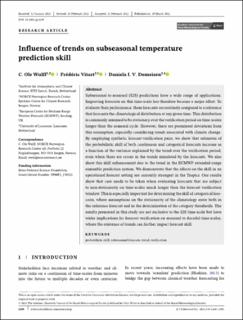| dc.contributor.author | Wulff, C. Ole | |
| dc.contributor.author | Vitart, Frédéric | |
| dc.contributor.author | Domeisen, Daniela I.V. | |
| dc.date.accessioned | 2022-06-15T10:59:46Z | |
| dc.date.available | 2022-06-15T10:59:46Z | |
| dc.date.created | 2022-05-11T11:09:13Z | |
| dc.date.issued | 2022 | |
| dc.identifier.citation | Quarterly Journal of the Royal Meteorological Society. 2022, 148 (744), 1280-1299. | en_US |
| dc.identifier.issn | 0035-9009 | |
| dc.identifier.uri | https://hdl.handle.net/11250/2998854 | |
| dc.description.abstract | Subseasonal-to-seasonal (S2S) predictions have a wide range of applications. Improving forecasts on this time-scale has therefore become a major effort. To evaluate their performance, these forecasts are routinely compared to a reference that forecasts the climatological distribution at any given time. This distribution is commonly assumed to be stationary over the verification period on time-scales longer than the seasonal cycle. However, there are prominent deviations from this assumption, especially considering trends associated with climate change. By employing synthetic forecast-verification pairs, we show that estimates of the probabilistic skill of both continuous and categorical forecasts increase as a function of the variance explained by the trend over the verification period, even when there are errors in the trends simulated by the forecasts. We also show this skill enhancement due to the trend in the ECMWF extended-range ensemble prediction system. We demonstrate that the effects on the skill in an operational forecast setting are currently strongest in the Tropics. Our results show that care needs to be taken when evaluating forecasts that are subject to non-stationarity on time-scales much longer than the forecast verification window. This is especially important for determining the skill of categorical forecasts, where assumptions on the stationarity of the climatology enter both in the reference forecast and in the determination of the category thresholds. The results presented in this study are not exclusive to the S2S time-scale but have wider implications for forecast verification on seasonal to decadal time-scales, where the existence of trends can further impact forecast skill. | en_US |
| dc.language.iso | eng | en_US |
| dc.rights | Navngivelse 4.0 Internasjonal | * |
| dc.rights.uri | http://creativecommons.org/licenses/by/4.0/deed.no | * |
| dc.title | Influence of trends on subseasonal temperature prediction skill | en_US |
| dc.title.alternative | Influence of trends on subseasonal temperature prediction skill | en_US |
| dc.type | Journal article | en_US |
| dc.type | Peer reviewed | en_US |
| dc.rights.holder | © 2022 The Authors | en_US |
| dc.description.version | publishedVersion | en_US |
| cristin.ispublished | true | |
| cristin.fulltext | original | |
| cristin.qualitycode | 2 | |
| dc.identifier.doi | 10.1002/qj.4259 | |
| dc.identifier.cristin | 2023422 | |
| dc.source.journal | Quarterly Journal of the Royal Meteorological Society | en_US |
| dc.source.volume | 148 | en_US |
| dc.source.issue | 744 | en_US |
| dc.source.pagenumber | 1280-1299 | en_US |

